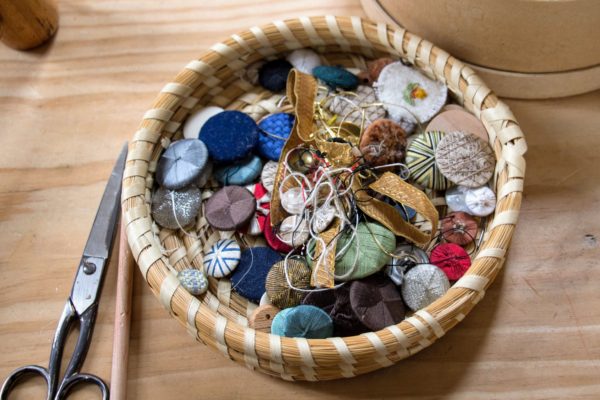
The fear of machinery replacing jobs is a fear as old as… invention itself. While it is easy to consider this a modern anxiety – cashiers being replaced by automated checkouts, industry being hit by mechanized assembly lines – the concern goes back centuries. Becoming obsolete is a frightening prospect in any era.
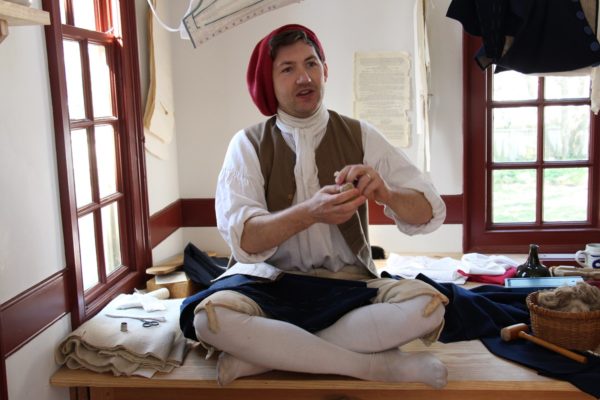
While sewing machines were not invented until 1829, the idea of them was known during 18th century. Tradespeople such as tailors, milliners & mantua makers, leather workers, bookbinders, and shoemakers understood the prospect of machines replacing them.
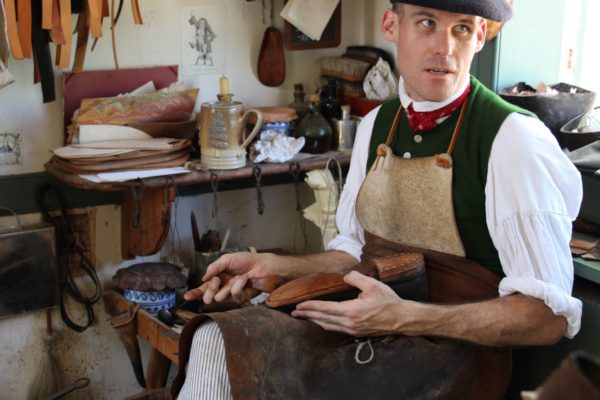
In 1589 the invention of the knitting machine, which could knit six times faster than a person, seemed to validate such worries. While the faster, more consistent machines did not wholly replace hand knitting, the innovations did gradually undermine its viability as a livelihood. Today, most people know someone who knits, but few make their living at it. Still, it is a favorite pastime of many of our orientation interpreters in between helping guests.
Wiesenthal’s mechanical sewing aid, which consisted of a double-pointed needle with an eye at one end, was patented in 1755 in England.
The first patent for a sewing machine was granted in 1790, but Thomas Saint did not successfully market his invention. It is believed he had a model machine but the drawings show that several improvements were needed before it was fully functional. He never secured the funding necessary to put a working machine into use.
If it had been more successful, Saint’s design (with minor modifications) would have aided leather workers and made it easier to sew ship sails. The drawings for his sewing machine didn’t resurface until 1874.

These innovations might have alarmed the tradespeople of 18th-century Williamsburg who depended on sewing. The threat to their livelihoods would have overshadowed any improvements offered by the machine. If the sewing machine promised to double productivity, perhaps half of them would be out of work. Those who remained would have the daunting task of learning a new skill.
The tradespeople had no way of knowing who would still have work at the end of the modernization process and who would be without. They would have felt the need to prove their value and skill level and they might have felt marginalized.
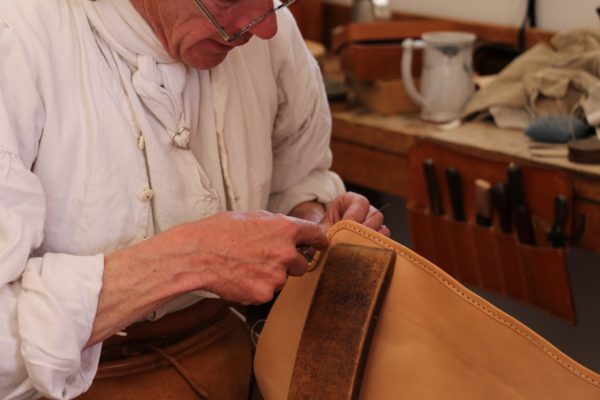
A sewing machine may be faster, but it isn’t necessarily stronger. Our milliners said they prefer hand-sewing even at home because it is quiet and allows you to sit with other people and talk rather than being isolated with a noisy sewing machine. Sewing by hand is a more human connection.
Not many people are as skillful at sewing by hand as our milliners, though! Sewing machines are still used to make the vast majority of clothing in the modern era.
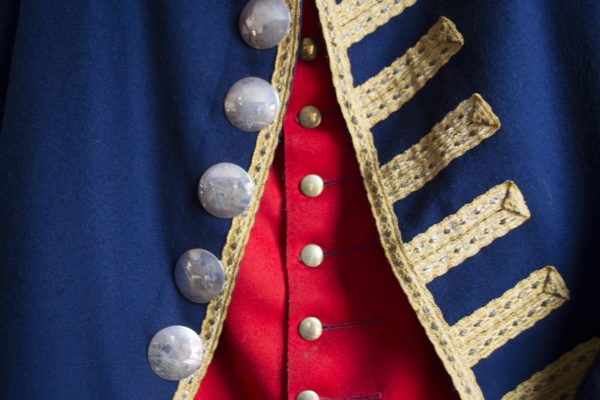
Barthélemy Thimonnier’s introduction of his sewing machine in Paris in 1829 marked the end of many livelihoods. When Thimonnier opened a factory in 1830, hoping to produce uniforms for the French Army, over 200 tailors rioted and burned down the factory. Thimmonier and others, such as Singer and Howe, improved upon his invention in the next 20 years, and soon sewing machines were adopted around the world. More than 110,000 machines were produced in the United States in 1860 alone.
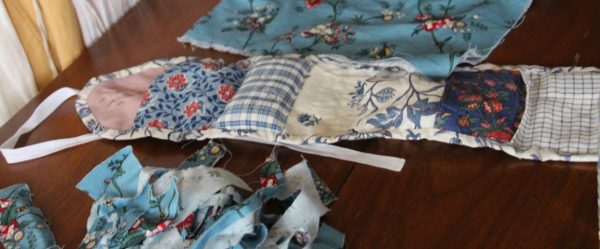
“Having clothing custom-made was not expensive, it was only 2.5 shillings to have a common gown made,” explained Janea. “The value was in the textiles, not in the labor. Therefore people of lower means could afford to pay someone else to cut and sew clothing for them.”
But poor or enslaved people would not have been treated as well in shops. This experience for the wealthy was sought out and enjoyed, much like it is today in modern exclusive clothing shops. The sewing machine did not immediately replace all hand work. Buttons and buttonholes were worked by hand into the 20th century. And many items were a combination of machine and hand. Some 19th-century gowns, for example, were largely made by machine, but had components like the long skirt seams that were still done by hand.
Despite all this mechanical progress, tailors, milliners, and mantua makers survived as viable trades. They even exist today. High-end stores, for example, still offer tailoring services. Janea Whitacre, Mistress Milliner and Mantua Maker, suggested that the exclusiveness and attention provided by these trades could have been their saving grace. Many people in the 18th century were capable of making clothes, but like today, those who could afford the luxury enjoyed the extras: tea, fawning, and feeling catered to.
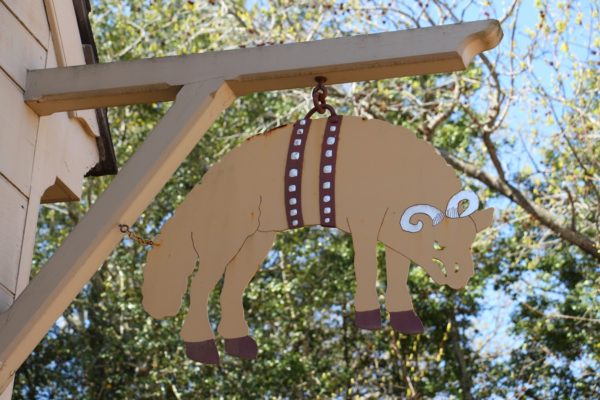
Our tradespeople at Colonial Williamsburg work hard to keep alive the skills that fed, clothed, and aided our ancestors. Mark Hutter, our Journeyman Supervisor Tailor, sums it up: “We do this work, not because we believe that we will have to return to these methods, but because we firmly believe that hand skills are the basis of industry and modernity. Every tool and computer only does what a person is capable of doing. But we are also too capable of allowing ourselves to be replaced by our inventions.” Our Milliners add: “Hand Sewing reminds you of the humanity held within our hands and the skill that a human possesses if you take the time to practice. It reminds us what we are truly capable of.”
The people of the past were very skilled, and our tradespeople keep these skills, some of which are on the brink of extinction, alive.

The trade shops are open on different days throughout the week – check the daily calendar to find the times. Don’t forget to visit our amazing sewing trades to find out more about these skills. We also have numerous other trades who deal with metalwork, wood-working, and brickmaking as well as other historical sites. All trade shops and historical sites can be visited with a single-day ticket, multi-day ticket or annual pass - any of which can be bought at our various ticket offices.
GUEST BLOGGER: MEGHAN MCNICHOLAS
 Meghan McNicholas has been with Colonial Williamsburg since 2016, when she moved to America from Dublin. She loves everything about Virginia – the history, the weather, the animals (except the mosquitoes), and the culture. Her favorite part of working for Colonial Williamsburg is the opportunity to go out into the historic area and interact with the interpreters and take photos.
Meghan McNicholas has been with Colonial Williamsburg since 2016, when she moved to America from Dublin. She loves everything about Virginia – the history, the weather, the animals (except the mosquitoes), and the culture. Her favorite part of working for Colonial Williamsburg is the opportunity to go out into the historic area and interact with the interpreters and take photos.
But next month Meghan and her husband Davis, one of our military interpreters, are taking her talents to upstate New York. We’ll miss them both, and we wish them the all good fortune on their new adventure!



Trying to the most helpful process to get Custom made educational essay producing guidance | Downside solved! Test our custom made essay creating program, dissertation crafting provider in British isles.
http://spotthepot.org/2016/10/approaches-of-writing-essays-as-well-as-the-2/
I love the historic trades! Can’t wait to stop in and see them when we visit in August-especially the Milliner’s shop!